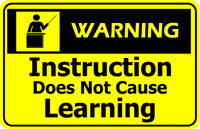Yesterday I ran across an article in The Atlantic showing “The School Of The Future” that lives in a local YMCA. While they don’t seem to have a Quidditch field or a landing pad for flying cars, it sounded like a nice idea. Working with the community, sharing the pool, innovating in education — what’s not to love?
Then I came to the author’s contention that “Eighty percent of charter schools don’t produce better results than traditional public education. And sadly, some results are much worse.” While not labeled as “op-ed”, I’m guessing Kathleen Kennedy Townsend does have a particular axe she’s trying to sharpen, here.
 Since I have a nodding familiarity with education, and more exposure to self-designated experts than is healthy for most adults, I wondered where this had come from. So I started doing some searching. And searching. Best I could do (‘cuz, of course, they don’t reveal SOURCES in the Atlantic) was some questionable research from a LARGE MAINSTREAM EDUCATIONAL INSTITUTION that had numbers that looked a little bit like that, if you read really quickly and ignored the details. And the source. And didn’t ask any questions.
Since I have a nodding familiarity with education, and more exposure to self-designated experts than is healthy for most adults, I wondered where this had come from. So I started doing some searching. And searching. Best I could do (‘cuz, of course, they don’t reveal SOURCES in the Atlantic) was some questionable research from a LARGE MAINSTREAM EDUCATIONAL INSTITUTION that had numbers that looked a little bit like that, if you read really quickly and ignored the details. And the source. And didn’t ask any questions.
(I don’t have anything against experts. Really. Some of my friends are experts. I’d even let my daughter marry one, if she was the last woman on earth and had a trust fund.) But in this case, I think it might be useful to stop for a moment and talk about the process of measuring results. Something that we do a lot in my line of business.
If a client hires me to teach punch press operators to run their machines faster, one option is for me to just show them how to turn the speed dial up to “11″ and step back. Job Done! The machines are now running faster, I’ve accomplished the goal, and I want my check. Ka-Ching!
(There will, of course, be a corresponding loss of fingers, an increase in damaged materials, lots of lawsuits, and explosions when the red-hot machines finally blow up — but I achieved my goal with 100% success!)
Still confused? Let’s make it even simpler. Let’s imagine that you’ve got a Dairy Barn. And you want “better results”.
Our goal is to get more milk from your herd. Each morning, we’ll measure how many gallons of milk you get from group “A” and how much from group “B” and see which is “BEST”. (Best, in this case, meaning more milk.)
At the end of the first week, Group “A” wins. With weak, runny milk because the foreman fed them food with lots of fluid. We couldn’t sell it because the fat content was so low, but there was more of it.
New goal — highest fat content.
At the end of week two, group “B” is the winner. The foreman ordered in extremely expensive food, which raised the fat content for the second group nice and high. But the cost per cow was triple what we usually pay, so we ended up selling the milk at a loss.
Week three — we aim for highest profits. And the foreman butchers all the cows and sells them at market, showing a huge profit. Oopsie.
So be careful when you hear people in Education talking about measuring results, or who gets “better results”. Without asking a lot of very specific questions, and without a lot of experience at designing and delivering actual education to actual people, you may get slaughtered.

{ 2 comments… read them below or add one }
Traditional schools in the state of Florida are failing students to the point that graduating high school students are fewer than a decade ago. Our children recognize value and seem to know that they are not getting it in school. Waiting for a better idea.
Schools don’t “fail students”. Students fail to successfully complete a curriculum. That can be for many, many reasons — it could be poor teaching, it could be the student isn’t properly prepared for the field of study, it could be that the content is beyond the current capability of the learner, it could be that the learner isn’t motivated (intrinsically or extrinsically) to learn the content.
In the majority of cases that I’ve encountered, it’s usually some combination of the above. Plus a lot of other environmental and societal factors beyond the control of the teacher and school.